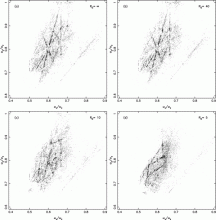
Abstract
We survey the properties of all orbit families in the rotating frame of a family of realistic triaxial potentials with central supermassive black holes. In such galaxies, most regular box orbits (vital for maintaining triaxiality) are associated with resonances which occupy two dimensional surfaces in configuration space. For slow figure rotation all orbit families are largely stable. At intermediate pattern speeds a significant fraction of the resonant box orbits as well as inner long-axis tubes are destabilized by the "envelope doubling'' that arises from the coriolis forces, and are driven into the destabilizing center. Thus for pattern rotation periods 200 Myr < T 5 Gyr, the two orbit families that are most important for maintaining triaxiality are highly chaotic. As pattern speed increases there is also a sharp decrease in the overall fraction of prograde short-axis tubes and a corresponding increase in the retrograde variety. At the highest pattern speeds (close to that of triaxial bars) boxlike orbits undergo a sudden transition to a new family of stable retrograde looplike orbits, which resemble orbits in 3-D bars, and circulate about the short axis. Our analysis implies that stable triaxial galaxies and dark matter halos (with central cusps and supermassive black holes) could either be slowly rotating or very rapidly rotating like fast bars, but equilibrium triaxial elliptical galaxies and dark matter halos with intermediate pattern speeds are unlikely to exist due to the high levels of stochasticity in both the box and inner long axis tube orbit families.